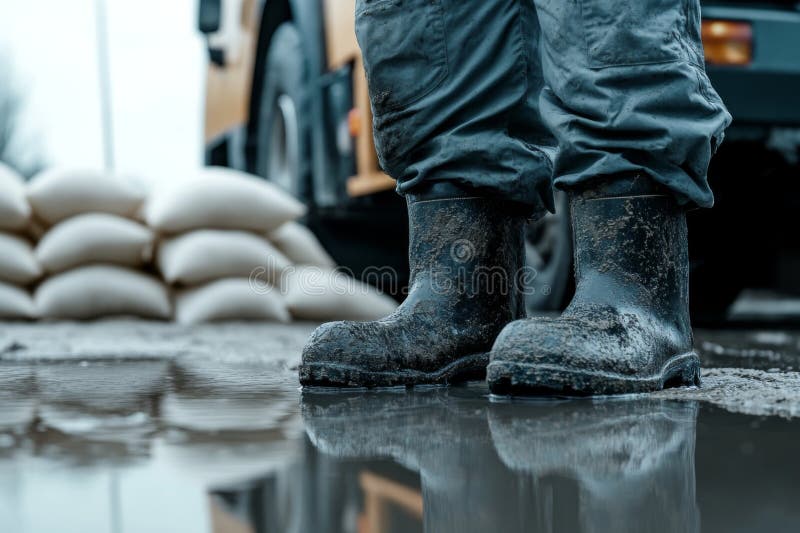Preparing For Floods: Understanding And Responding To Flood Alerts

Table of Contents
Understanding Flood Alerts and Warnings
The first step in flood preparedness is understanding the different types of flood alerts and what actions they require. Knowing the difference between a watch, warning, and advisory can save valuable time and potentially lives.
- Flood Watch: This means that conditions are favorable for flooding to occur. Be prepared to act quickly if conditions worsen.
- What to do: Monitor weather reports closely, review your flood preparedness plan, and gather essential supplies.
- Flood Warning: Flooding is occurring or is imminent. Take immediate action to protect yourself and your property.
- What to do: Evacuate if instructed, move valuable items to higher ground, and prepare for potential power outages.
- Flood Advisory: Flooding is possible in specific areas. While not as urgent as a warning, it still calls for caution and awareness.
- What to do: Stay informed, avoid driving through floodwaters, and be prepared for potential disruptions.
Flood alerts are disseminated through various channels:
- NOAA Weather Radio: A dedicated, reliable source for weather alerts, including flood warnings.
- Mobile Apps: Numerous weather apps provide real-time alerts and forecasts.
- Local News: Television and radio stations often provide timely flood updates and evacuation instructions.
- Emergency Alert System (EAS): This system transmits urgent alerts through television and radio broadcasts.
It is crucial to utilize multiple alert sources to ensure you receive timely and accurate information. Sign up for local emergency alerts through your community's website or emergency management agency.
Creating a Flood Preparedness Plan
A well-defined family emergency plan is crucial for surviving a flood. This plan should include:
-
Identifying Flood Risks: Check floodplain maps available online (often through FEMA or your local government) to determine your risk level. Review historical flood data for your area to understand past flood patterns.
-
Developing an Evacuation Plan: Identify multiple escape routes, designated meeting points outside the flood zone, and pre-arrange transportation, if needed. Plan for pets too! They are members of your family!
-
Creating a Go-Bag: Assemble an emergency kit containing essential supplies, including:
- Water (at least one gallon per person per day for several days)
- Non-perishable food
- First-aid kit
- Medications
- Important documents (copies of insurance policies, identification)
- Flashlight and extra batteries
- Whistle
- Radio
-
Protecting Valuables: Elevate valuable documents and electronics to prevent water damage. Consider waterproof storage containers.
Protecting Your Home and Property from Flood Damage
Several measures can reduce your home's vulnerability to flood damage:
- Home Improvements: Consider elevating electrical systems and appliances, installing flood barriers, or waterproofing your basement.
- Flood Insurance: Purchasing flood insurance is a vital step, as many homeowners' insurance policies do not cover flood damage.
- Community Mitigation: Understand your community's flood mitigation efforts, such as drainage improvements or levee systems.
Before a flood:
- Move valuables to higher ground.
- Disconnect electrical appliances.
- Bring outdoor furniture and equipment inside.
During a flood:
- Evacuate if instructed.
- Monitor rising waters closely.
- Avoid contact with floodwaters.
After a flood:
- Prioritize safety – be cautious of downed power lines, contaminated water, and structural damage.
- Contact your insurance company.
- Document damages with photos and videos.
- The strategic use of sandbags can significantly protect your property from floodwaters.
Responding to a Flood Emergency
Immediate action upon receiving a flood warning is paramount. Safe evacuation procedures are essential, and you need a plan!
- Safe Evacuation: If instructed to evacuate, do so immediately. Follow designated routes and heed instructions from emergency personnel.
- Dealing with Floodwaters: Never attempt to drive or walk through floodwaters. The depth can be deceiving, and the water may contain hazardous materials.
- Potential Hazards: Be aware of downed power lines, contaminated water, and unstable structures.
If trapped by floodwaters:
- Seek higher ground immediately.
- Signal for help using a whistle or bright cloth.
- Stay informed on weather conditions.
- Contact emergency services.
Conclusion
Preparing for floods is a crucial step in protecting your family and property. Understanding flood alerts, developing a comprehensive preparedness plan, protecting your home, and responding effectively to a flood emergency are essential components of flood safety. Don't wait for a flood warning to act! Start planning your flood safety strategy today by creating a comprehensive flood preparedness plan. Utilize the resources mentioned above to better understand flood alerts and ensure the safety of you and your family. Take proactive steps toward flood preparedness; your safety depends on it.

Featured Posts
-
 Atletico Madrid In Sevilla Zaferi Macin Oenemli Anlari Ve Goller
May 26, 2025
Atletico Madrid In Sevilla Zaferi Macin Oenemli Anlari Ve Goller
May 26, 2025 -
 Le Frere Aine De Thierry Luthers Albert Est Decede
May 26, 2025
Le Frere Aine De Thierry Luthers Albert Est Decede
May 26, 2025 -
 Paris Roubaix 2024 Van Der Poels Third Place Finish Pogacar A Minute Behind
May 26, 2025
Paris Roubaix 2024 Van Der Poels Third Place Finish Pogacar A Minute Behind
May 26, 2025 -
 A Fathers Strength Jonathan Peretz Navigates Grief And Finds Joy
May 26, 2025
A Fathers Strength Jonathan Peretz Navigates Grief And Finds Joy
May 26, 2025 -
 Thursdays Must See Tv Top 10 Streaming And Broadcast Picks
May 26, 2025
Thursdays Must See Tv Top 10 Streaming And Broadcast Picks
May 26, 2025
Latest Posts
-
 Sabato 8 Marzo Almanacco Santo Del Giorno Compleanni E Proverbio
May 27, 2025
Sabato 8 Marzo Almanacco Santo Del Giorno Compleanni E Proverbio
May 27, 2025 -
 8 Marzo Almanacco Della Giornata Eventi Storici Compleanni E Proverbio
May 27, 2025
8 Marzo Almanacco Della Giornata Eventi Storici Compleanni E Proverbio
May 27, 2025 -
 Almanacco Del Sabato 8 Marzo Eventi Compleanni Santo E Proverbio
May 27, 2025
Almanacco Del Sabato 8 Marzo Eventi Compleanni Santo E Proverbio
May 27, 2025 -
 Chelsea Transfer News Joaquin Panichelli In The Frame
May 27, 2025
Chelsea Transfer News Joaquin Panichelli In The Frame
May 27, 2025 -
 Latest On Chelseas Pursuit Of Joaquin Panichelli
May 27, 2025
Latest On Chelseas Pursuit Of Joaquin Panichelli
May 27, 2025
